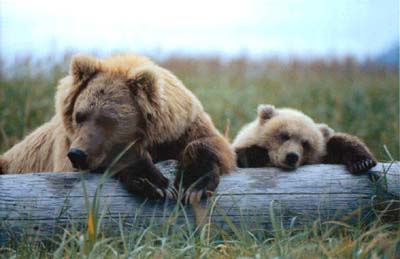Life History and Reproduction
Grizzly bears have an extremely low reproductive rate. This is caused by
a variety of factors. Female grizzly bears reach sexual maturity between the
ages of five and eight. With the lifespan of grizzlies being
about 20-25 years, that would be comparable to a human female reaching
sexual maturity at age 21 (Horejsi, 2008). With this large portion of their
lifespan spent as sexually immature, reproduction rates are significantly
lower than most terrestrial animals.
The struggles
of reproduction don’t end after reaching sexual maturity. Finding a mate is
difficult for grizzly bears due to their largely solitary lifestyles
(National, 2011). When a
female is ready for a mate, she
emits a scent which males can pick up from miles away. Male grizzlies have
large territories, however, spanning up to 1,500 square miles (Horejsi,
2008). This range makes it difficult for males to detect their potential mates.
Grizzly bears
mate between the months of June and July (MacDonald, n.d.). Once a female breeds with a male, the fertilized
egg doesn’t implant shortly after conception like in many mammals. Female grizzly bears
experience delayed implantation in which implantation of the fertilized egg
is held off until just before hibernation. If the female doesn’t have the
proper nutrients during hibernation, she may miscarry. Once the fertilized
egg implants, grizzly bears have a gestation period of six to eight weeks
and give birth during hibernation (Teel, 2008).
Another factor that influences grizzly bears’ low reproduction is the amount
of offspring that female grizzly bears produce. An average litter yields two
cubs, but may range anywhere from one to four cubs (MacDonald, n.d.). After the birth of a
litter, the mother cares for her cubs for two to three years until the cub
is old enough to live on its own. During this time, the mother teaches her
young how to find food and dig a den (Austin, 2002). The mother will not
breed while she cares for her cubs. Females may also wait up to three years
after their cubs leave to breed again (Payton, 2001). Because of this slow
rate of reproduction, the grizzly population is also slow at recovering from
negative ecological factors (Horejsi, 2008).
U.S. Geological Survey
